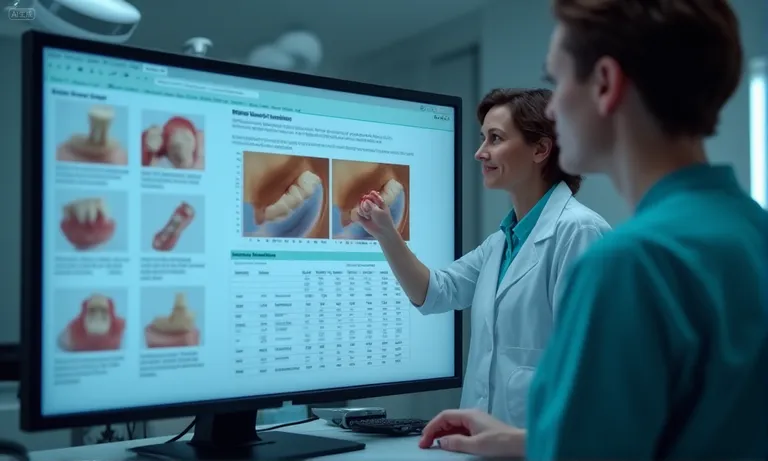Consistency is a decisive success factor in complex dental implant cases. Even small variations in materials, workflows, or communication can escalate into costly remakes, delayed delivery, and reduced patient satisfaction. For procurement teams and group practices, consistency translates into predictable quality, dependable turnaround times, and a stable supply chain.
Key areas that determine consistency include:
- Material standards – how zirconia, PFM, or titanium affect durability, fit, and long-term outcomes.
- Digital workflow integration – CAD/CAM precision, STL file compatibility, and error-free communication.
- Lab quality controls – remake rates, QA checkpoints, and compliance with ISO or CE standards.
- Risk management measures – pilot cases, clear remake policies, and structured communication protocols.
These are not abstract benchmarks—they directly shape clinical efficiency, patient trust, and overall treatment costs. By focusing on these factors, clinics, DSOs, and distributors can reduce variability and align with dental labs that consistently deliver reliable results. The outcome is lower operational risk, smoother workflows, and stronger long-term partnerships. In implant dentistry, consistency is not just about quality—it is the foundation of sustainable collaboration.
Why Is Consistency Critical in Complex Dental Implant Cases?
Consistency in complex dental implant cases determines whether restorations succeed both clinically and financially. Without stable processes and predictable results, buyers encounter higher risks of remakes, extended chair time, and dissatisfied patients. Procurement teams and group practices now view supplier consistency as a primary selection criterion because it directly impacts costs, efficiency, and patient trust.

implant-restoration-consistency-importance
What challenges do buyers face in complex implant restorations?
Buyers often face unexpected difficulties when coordinating complex implant workflows.
- Variability across labs results in inconsistent quality.
- Misaligned STL files or shading instructions cause costly remakes.
- Overseas sourcing sometimes introduces shipping delays or regulatory complexity.
From our perspective as an overseas dental lab, procurement managers frequently emphasize how small inconsistencies in early stages lead to significant downstream disruptions for clinics.
How does inconsistency increase costs, delays, and rework rates?
Inconsistent results generate hidden financial and operational costs.
- Each remake adds lab fees, shipping charges, and wasted chair time.
- Poor fit leads to extra adjustments, stretching clinic schedules.
- Patient dissatisfaction from delays weakens long-term trust and referrals.
Industry estimates suggest that unpredictable suppliers can raise total case costs by 20–30% compared to consistent partners.
Why procurement teams prioritize supplier consistency in implant workflows?
Procurement professionals rank consistency highly when selecting labs.
- Predictable outcomes simplify budgeting and scheduling.
- Reliable labs enable clinics to scale services across multiple sites.
- Consistency strengthens trust, particularly for DSOs managing high volumes.
As a result, consistency often outweighs speed or even price in procurement decisions.
Industry references such as “A full digital workflow to prefabricate an implant-supported interim restoration” demonstrate how structured digital processes reduce variation and improve predictability—reinforcing why consistency is indispensable in implant workflows.
What Factors Influence Consistency in Complex Implant Restorations?
Consistency in complex implant restorations results from harmonizing materials, digital processes, trained personnel, and quality checkpoints. When these dimensions align, restorations become predictable and scalable; when mismatched, inconsistencies surface — triggering delays, remakes, and increased costs.

implant-restoration-consistency-factors
How do material choices (zirconia, PFM, titanium) affect long-term outcomes?
Material selection sets the baseline for restoration performance:
- Zirconia: high strength and esthetics; generally produces fewer remakes.
- Titanium: trusted for structural support and excellent osseointegration.
- PFM (Porcelain-fused-to-metal): cost-effective but prone to chipping or color mismatches.
Misalignment between material strengths and case demands often leads to increased chairside adjustments or inconsistent durability.
Why is digital workflow integration (CAD/CAM, STL file compatibility) crucial?
Digital workflow ensures precision and traceability across systems. Seamless CAD/CAM use depends on accurate STL file interoperability, scanner calibration, and synchronized design libraries. In contrast, mismatched formats or outdated software often cause production errors or delays.
How do lab process controls and technician expertise ensure repeatability?
Predictable outcomes demand disciplined execution:
- Consistent margin marking and wax-up protocols.
- Cross-verification before milling, sintering, or finishing.
- Maintaining technician continuity across similar cases.
From our perspective as an overseas dental lab, variability in technician training often emerges as the most common source of restoration inconsistency.
What role do standardized protocols and QA checkpoints play in minimizing errors?
Quality at each stage eliminates surprises:
- Dimensional checks ensure precise fit of abutments and prosthetics.
- Shade matching verifies against submitted shade guides.
- Lot tracking supports traceability from materials to final restoration.
Labs embedding QA throughout the process consistently report lower remake rates and higher procurement trust.
Consistency emerges when material reliability, digital precision, skilled execution, and QA combine effectively. Evidence such as the study comparing digital vs conventional prosthetic workflows for dental implants illustrates how digital integration reduces workflow errors and enhances predictability
How to Evaluate Whether a Dental Lab Can Deliver Consistent Results
Evaluating a dental lab’s consistency is not just about price—it is about measurable reliability. Buyers can assess this by examining QA policies, remake rates, certifications, turnaround history, and structured procurement checklists. Labs that meet these benchmarks deliver predictable outcomes and reduce long-term risks for clinics and procurement teams.

dental-lab-consistency-evaluation
What QA policies and remake rates should buyers verify?
Consistent labs operate under documented QA policies. Procurement teams should request:
- Remake rates (ideally below 3–5% for complex implant cases).
- Defined QA checkpoints at design, milling, and finishing stages.
- Lot tracking for materials and implant components.
Labs unwilling to share remake data often lack transparency in quality management.
Which certifications and compliance standards demonstrate reliability?
Certifications validate a lab’s adherence to international standards. Key benchmarks include:
- ISO 13485 for medical device quality systems.
- CE marking for compliance with EU requirements.
- FDA registration for U.S.-bound cases.
Procurement teams gain confidence when labs align with globally recognized standards.
How can turnaround time history indicate lab stability?
Delivery history reveals operational consistency. Buyers should look for:
- Stable turnaround times across repeat cases.
- Transparent communication on delays.
- Ability to scale capacity without sacrificing quality.
Labs with erratic delivery patterns often struggle with internal workflow discipline.
What procurement checklists help assess consistency before partnership?
A structured checklist prevents oversight. Critical items include:
- Documented QA processes and remake data.
- Certifications and regulatory compliance.
- Turnaround benchmarks for similar complex cases.
- References or case studies with group practices or DSOs.
Procurement teams that use structured evaluation tools minimize risk and avoid costly supplier changes later.
For further validation, see the International Organization for Standardization (ISO) 13485 overview, which explains the quality system requirements most buyers use as a baseline when evaluating dental labs.
Best Practices for Reducing Risks in Complex Implant Collaboration
Reducing risks in complex implant collaboration requires proactive alignment between clinics and dental labs. Clear communication, structured trial runs, and transparent remake policies ensure that workflows remain predictable and minimize costly surprises for procurement teams and clinicians alike.

implant-collaboration-risk-reduction
How to set clear file submission and communication protocols with labs?
Misaligned file formats or missing details are among the most common sources of rework. Clinics and labs should establish:
- Standardized STL file submission templates.
- Clear shade and margin-marking guidelines.
- Defined communication timelines for feedback loops.
Labs that adopt structured file protocols report fewer remake cases and smoother project flow.
Why are pilot cases or trial orders effective for testing consistency?
Trial orders allow procurement teams to test workflows without committing fully. Benefits include:
- Identifying potential mismatches in expectations.
- Verifying delivery times on real but controlled cases.
- Assessing the lab’s response to revision requests.
Successful pilot cases build confidence before scaling to high-volume or complex restorations.
How do transparent remake policies and documentation reduce supplier risk?
Unclear remake terms often result in disputes. To avoid this, labs should:
- Provide written remake policies upfront.
- Track remake requests and reasons in case files.
- Share documentation on material batches and digital design changes.
This transparency reassures buyers that accountability is built into the partnership.
Risk reduction is not only about avoiding mistakes—it is about setting the foundation for scalable collaboration. Research on communication protocols in digital dentistry confirms that structured digital exchanges significantly cut down on production errors and misalignments.
How Consistency Creates Value in Long-Term Lab Partnerships
Consistency in dental lab performance transforms from a quality control concern into a strategic advantage. Predictable results reduce hidden costs, streamline clinic operations, and strengthen long-term trust—factors especially valued by DSOs and group practices managing high case volumes.

long-term-dental-lab-partnership-value
What cost savings result from fewer remakes and predictable processes?
Each remake adds material, labor, and shipping costs that accumulate quickly. Labs delivering consistent quality:
- Lower the average cost per case.
- Reduce hidden costs from delays and adjustments.
- Provide predictable budgeting for procurement teams.
Over time, stable performance translates into measurable financial savings.
How does consistent quality improve clinic efficiency and reputation?
Efficiency gains extend beyond the lab relationship. With consistent outcomes:
- Clinics spend less chairside time adjusting restorations.
- Treatment schedules run on time, improving patient flow.
- Patients experience higher satisfaction, leading to stronger word-of-mouth reputation.
These factors enhance the clinic’s competitive position in the local market.
Why do DSOs and group practices prefer labs with proven stability?
Large buyers like DSOs manage thousands of cases annually. For them, supplier consistency means:
- Reduced management overhead in procurement.
- Confidence that workflows can scale across multiple locations.
- Assurance that quality will not fluctuate across cases.
In the long term, consistency is not just about avoiding problems—it becomes the foundation for building scalable, trusted partnerships between clinics and their overseas dental labs.
Conclusion
Consistency is the hidden driver of success in complex implant restorations. When labs deliver predictable quality, procurement teams gain control over costs, clinics improve efficiency, and patients benefit from reliable outcomes. Across multiple cases, this stability compounds into stronger reputations and measurable ROI.
From our perspective as an overseas dental lab, we have seen how structured protocols, digital workflows, and clear remake policies transform uncertainty into trust. Clinics and DSOs that partner with stable, quality-driven labs not only reduce risks but also unlock long-term value. In the end, consistency is not just about standardization—it is about building partnerships that last.


